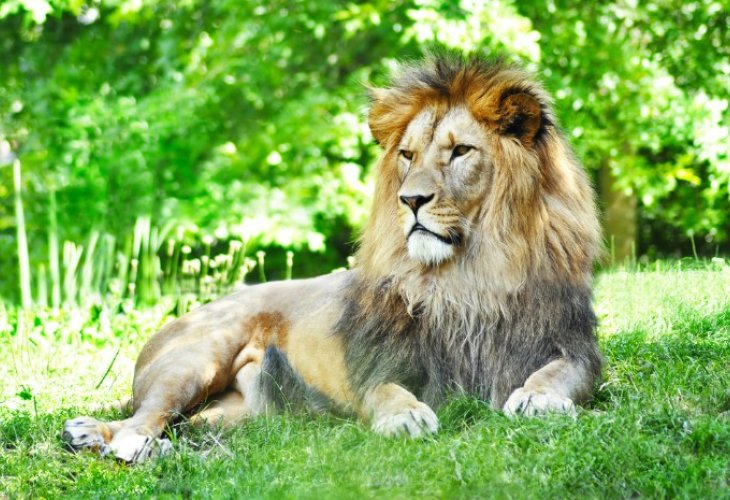Wonders of Creation
The Lion: King of Beasts and Symbol of Strength
Explore the lion’s power, hunting skills, family life, and the deep symbolism it holds in culture and tradition

God endowed the lion with natural majesty. Its noble appearance, crowned with a mane and exuding strength, inspires awe and a sense of royalty in all who behold it. The lion embodies courage, agility, power, confidence, and daring — qualities that make it feared by all other animals of the wild.
Standing about one meter tall, stretching up to two meters in length, and weighing as much as 250 kilograms, the lion’s body is perfectly adapted for hunting. With exceptionally strong bones, powerful chest muscles, and fearsome jaws, it can chase down prey, and overpower it with ease. Its forepaws are massive and armed with sharp claws, strong enough to bring down and grip prey three times its weight. Soft pads under its paws muffle its steps, allowing it to stalk prey silently. Its long tail ends in a tuft of hardened tissue wrapped in hair, capable of delivering a deadly blow.
The lion has extraordinarily sharp vision, capable of spotting prey from kilometers away. In fact, its eyes are the largest of any land-dwelling predator. Its hearing is equally acute, and with ears that swivel in every direction, the lion can detect sounds even from within thick brush.
The Lion’s Lifestyle
By day, lions rest lazily in groups of four or five, lounging together in thickets and savannas. At dusk, however, they awaken to hunt. Lions often lie in wait near springs, wells, or rivers. When prey approaches for water, the lion crouches low, stretches its muscles, waits patiently, and then suddenly leaps from its hiding place, striking with crushing force.
Though powerful, lions generally avoid very large animals such as elephants, rhinos, and buffalo, attacking them only in rare cases. Lions also do not usually attack humans, except in times of extreme hunger.
The Lioness: Hunter and Mother
The lioness is smaller than the male, weighing about half as much and lacking the mane that makes the male so distinctive. Lions belong to the cat family, yet unlike other big cats, they are the only ones to live in social groups. Within these prides, they show affection and respect to each other, sometimes rubbing against one another in greeting.
At night, lions often sleep huddled closely together, even lying on top of one another, sharing warmth and comfort. Each pride controls its own territory, often won by defeating older or weaker rivals. They defend their land fiercely, driving away intruding groups.
Hunting in Teams
Because food is not always easy to obtain, lions hunt in coordinated groups. The hunt typically unfolds in two stages: one group of lions stealthily circles around a herd of animals and waits in ambush, while the second group suddenly appears from the front, causing panic and driving the prey directly toward the waiting lions.
Interestingly, most of the actual hunting is done by lionesses, while the male lion often lounges and dozes. When lionesses succeed in killing a large animal, such as a bison, which they cannot drag back on their own, the lion finally joins in — proving his strength by hauling the prey to their shared den.
In group hunts, lions succeed about two times out of five. A lone lion, however, usually succeeds only once in six attempts. When unsuccessful for days, lions may resort to eating smaller creatures such as snakes, porcupines, or even worms.
Cubs and Family Life
Every two years, usually in spring, the lioness gives birth to two to four cubs after a gestation of 110 days. She is extremely protective, hiding them even from other lionesses during the early weeks. Like a house cat, she carries her cubs gently in her jaws, fiercely guarding them from predators such as hyenas and leopards. Cubs are never left unattended.
Despite their ferocity, lions are tender with their young. A mighty male may allow his cub to tug at his mane or tail, so long as he is not hungry.
Newborn cubs are about 30 centimeters long and are covered with faint dark spots, which fade as they grow. By six months, they are weaned from their mother’s milk and begin eating scraps of prey. At around 15 months, they join the pride’s hunts.
Symbol of Strength and Spiritual Meaning
Throughout history, the lion has been a symbol of strength, majesty, and even holiness in Jewish tradition. Shlomo Hamelech (King Solomon) adorned the Temple’s platforms with lion figures (Melachimm I, 7:29). Maimonides described the Temple’s structure as resembling the form of a lion — broad at the front and narrow at the back (Hilchot Beit HaBechirah 4:10).
Many of the sages reflected on the lion’s traits, teaching the Jewish people lessons about courage, discipline, and service to God.

